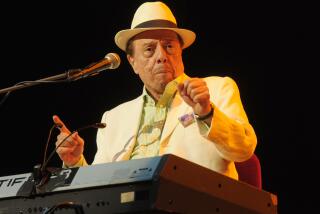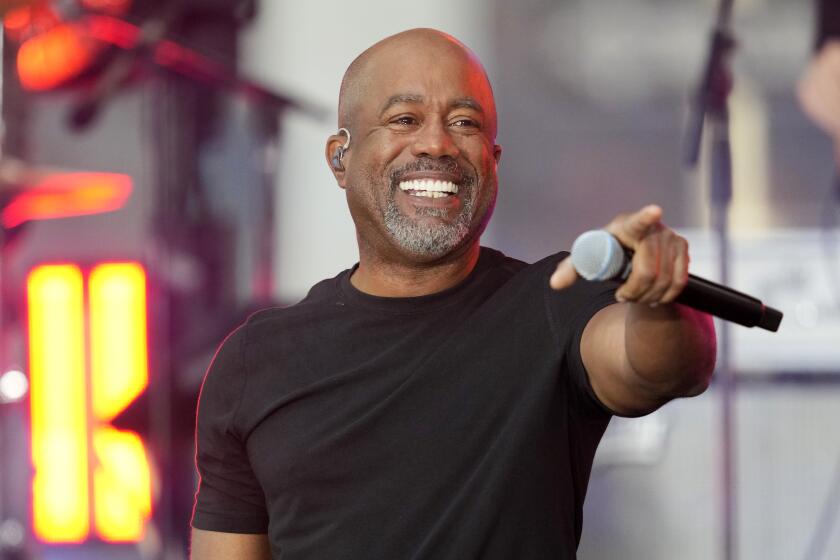Exuberant Fans of Bossa Nova’s Subtle Sounds
Singer Dewey Erney had just gotten married in 1962 when he first heard the songs of Antonio Carlos Jobim being performed by guitarist Charlie Byrd in a Washington, D.C., nightclub called the Showboat Lounge.
“Byrd had just been to Brazil, and he was playing such songs as ‘One Note Samba,’ ‘O Grande Amor’ ‘Desafinado,’ ” Erney said.
“Stan Getz was in the club one night, and I overheard him having a conversation about making an album of this music. I felt like I was on the ground floor of a new movement. The music was so lyrical, so beautiful. It had a lightness that’s so appealing, it just seemed to float.”
Saxophonist Getz went on to record his first Brazilian-influenced album, “Jazz Samba,” with Byrd and, in 1964, “Getz/Gilberto” with singers Joao and Astrud Gilberto, the album that introduced Jobim’s “The Girl From Ipanema” to the U.S.
Erney--who was in the U.S. Navy and stationed in the nation’s capital, where he sang occasionally in Byrd’s club at the time he first heard bossa nova--has continued a love affair with Jobim’s music and will include two or three Jobim tunes on his upcoming album.
More evidence of that affair can be heard when Erney, vocalist Stephanie Haynes and bassist-vocalist Jack Prather, the core group of the Great American Music Co., present “The Music of Antonio Carlos Jobim” tonight and July 27 at De Mario’s Cafe in Dana Point.
Prather, who creates the informative narrative that weaves the company’s tributes together, said he first became interested in bossa nova listening to trumpeter Dizzy Gillespie.
“It was in a small club in Dayton, Ohio, called the Esquire Lounge, and [pianist] Lalo Schifrin was in Gillespie’s band,” Prather said. “They had just gotten back from Brazil, and I think they were playing [Jobim’s] ‘No More Blues.’ You could tell they were affected deeply by the music, even though they were playing the song in kind of a roughshod, exuberant way, not the way at all that Jobim would do it.”
Then there was the soundtrack to “Black Orpheus,” Marcel Camus’ 1959 Brazilian film set against carnival in Rio de Janiero, with a score written largely by Jobim and fellow Brazilian Luis Bonfa.
“It’s the most beautiful color movie I’ve seen in my life,” Prather said. “But when I bought the soundtrack, which is full of street samba, I could hardly hear the songs because they’re so littered with drums. Bossa nova took all the drums out, put more emphasis on the melody, and the music became far cleaner. It took samba to another, more sophisticated place.”
Bossa nova--which translates to “new wave” or “new disturbance”--has its roots in traditional samba and the classical music of such Brazilian composers as Heitor Villa Lobos. It also was influenced by the nuances of American jazz.
It became popular in Brazil in 1959 with the release of Gilberto’s album “Chega de Saudade,” its title tune written by Jobim and Vinicius de Moraes. Instead of the prevailing style of strong singers and rhythms, bossa nova used more subtle beats and syncopations, reserved vocals and more involved harmonic structures than heard in previous Brazilian music. The rhythms of bossa nova often carried the syncopation and accents of jazz.
Jobim, Gilberto and Bonfa “were very influenced by West Coast jazz,” Prather said. “Joao was very influenced by Chet Baker’s singing. When Jobim was trying to think of a way to make his music come alive, he thought of Gerry Mulligan and West Coast jazz.”
Haynes said her introduction to Jobim came when her brother made her listen to Jobim’s collaborative recording with Nelson Riddle, “The Wonderful World of Antonio Carlos Jobim.”
“I played that album so much I nearly wore it out,” she said.
“I don’t know why, but I feel a great affinity for that music,” added Haynes, a singer known for her attention to rhythm. “The jazz-styled harmonies and Brazilian rhythm, the way the songs are sung slightly ahead of the beat, not in any affected way, but in a way the music should be sung, to make the supporting rhythm sound right.”
Haynes, who sings some of Jobim’s songs in Portuguese, said the language is so expressive, “it makes the feeling of the lyrics very easy to understand, even to those of us who don’t speak Portuguese.”
“That’s the wonderful thing about the music,” Prather added. “Its emotional range. It’s a cooled-down samba, but still with a contagious joy. There’s a touching sadness in the music, an introspective stillness, of the kind you hear in the work of Miles Davis and Gil Evans, or in a Bill Evans ballad. This kind of soul-touching sadness is unusual in music.”
The Great American Music Co. presents “The Music of Antonio Carlos Jobim” tonight at 7 at De Mario’s Cafe, Monarch Plaza No. 17, Dana Point. $10 cover. Also July 27. (949) 240-9436.
More to Read
The biggest entertainment stories
Get our big stories about Hollywood, film, television, music, arts, culture and more right in your inbox as soon as they publish.
You may occasionally receive promotional content from the Los Angeles Times.










